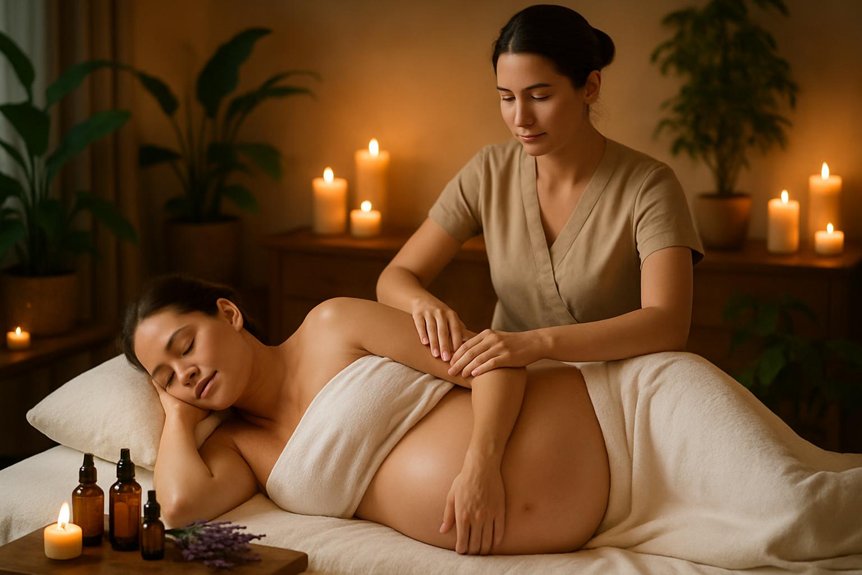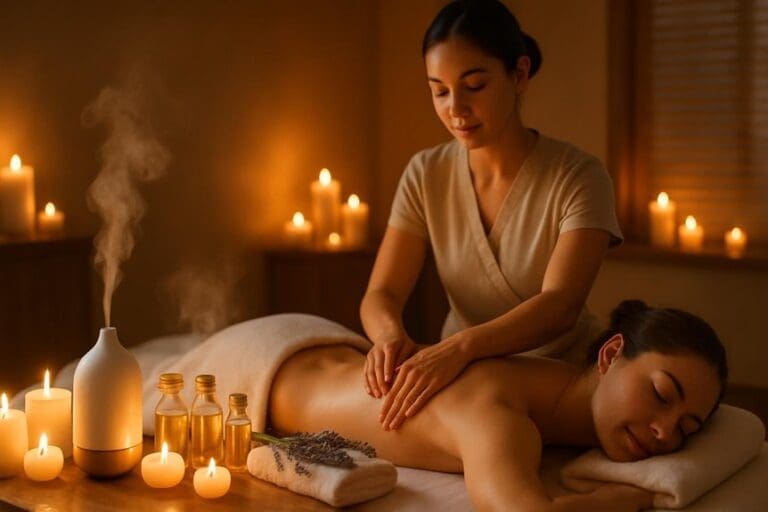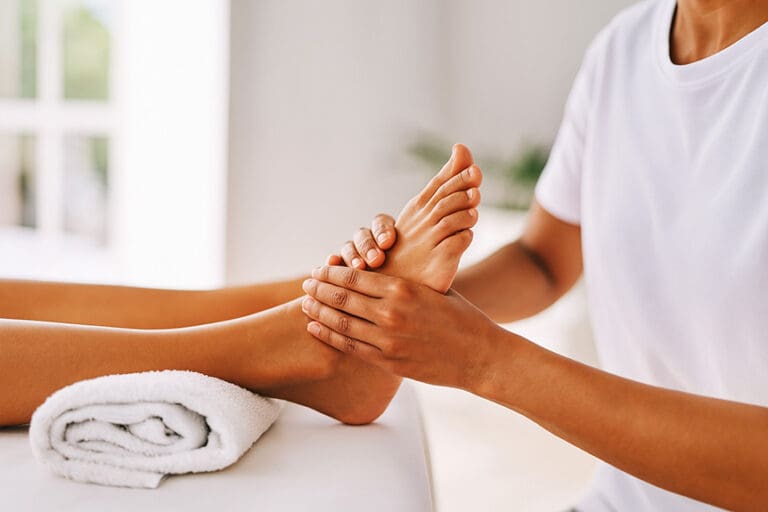Yes—when delivered by a trained pregnancy massage therapist, aromatic massage at 30 weeks can be safe. It uses side‑lying positioning, light to moderate pressure, and low‑dose, pregnancy‑appropriate essential oils (e.g., lavender, mandarin). Oils such as clary sage, rosemary, juniper berry, cinnamon bark, wintergreen, and Dalmatian sage are avoided; peppermint is limited. Thorough screening for high‑risk conditions and red‑flag symptoms is essential, with treatment deferred if concerns arise. It may help pain, sleep, and relaxation, with further details outlined below.
Is Essential Oil Massage Safe at 30 Weeks of Pregnancy?
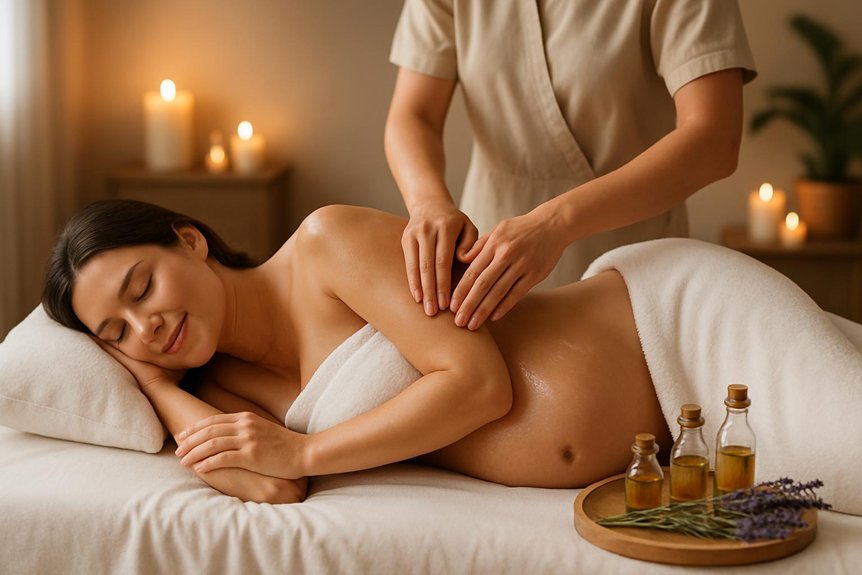
While many pregnant clients seek relief from tension and poor sleep in the third trimester, aromatherapy massage at 30 weeks can be safe when delivered by trained practitioners using pregnancy-specific protocols.
At Spa & Massage, therapists follow side-lying positioning with careful bolstering, avoid abdominal pressure, and select low-dose essential oils considered pregnancy-appropriate, such as lavender or mandarin, while excluding contraindicated oils.
A patch test and detailed consultation screen for high-risk factors—pre-eclampsia, placenta previa, reduced fetal movements, unexplained bleeding, or recent complications—prompting medical clearance or deferral.
Dilutions typically remain at 1% or less. Gentle, rhythmic strokes support comfort without deep pressure to the calves or inner thighs, reducing thrombotic risk.
Therapists monitor for dizziness, headache, or nausea, adapt session length, and emphasise hydration and unhurried progressions post-treatment.
In addition to relaxation, pregnancy massage can provide various benefits of pregnancy massage for expecting mothers, such as easing muscle aches and supporting better sleep.
Benefits You May Experience in the Third Trimester
Although individual responses vary, evidence and clinical experience indicate that aromatic massage in the third trimester may support several outcomes: reduced perceived musculoskeletal pain (especially lumbar, pelvic, and shoulder tension), improved sleep quality, and lower self-reported anxiety.
Observed benefits typically relate to modulation of stress physiology, gentle soft-tissue release, and a sense of safe touch.
When delivered with pregnancy positioning and light–moderate pressure, clients often report easier breathing, fewer night-time awakenings, and less leg heaviness.
At Spa & Massage clinics in London, therapists adapt techniques to accommodate postural change and fluid shifts common after 28 weeks, aiming to calm the nervous system and ease load-bearing tissues.
Sessions may also encourage better body awareness, facilitating pacing, breath focus, and restorative rest between appointments.
Outcomes are monitored and adjusted session by session.
Essential Oils We Use and Avoid During Pregnancy
Therapists at Spa & Massage support third-trimester comfort with light–moderate pressure and pregnancy positioning, and the same cautious approach guides oil selection.
In our clinics, aromatherapy blends are kept simple, low-dose, and patch-tested when needed. Preferred essentials include lavender (true), mandarin or sweet orange, frankincense, bergamot FCF, chamomile (Roman), and ginger—each diluted to about 1% in neutral carrier oils such as sweet almond or grapeseed.
These selections are used for calming, queasiness, and gentle muscle ease, while monitoring individual sensitivities.
Oils avoided in pregnancy include clary sage, rosemary, juniper berry, cinnamon bark, wintergreen, sage (Dalmatian), and high-thujone or high-ketone oils (e.g., wormwood).
Peppermint is limited. Undiluted application is never used.
Clients are invited to disclose medical history and preferences so blends remain conservative, supportive, and intimate to their needs.
How We Adapt Your Massage Positioning at 30 Weeks
At around 30 weeks, Spa & Massage therapists shift clients to a side‑lying support setup to reduce aortocaval compression and optimise maternal comfort and fetal safety.
Positioning is adjusted with targeted cushioning and bolstering—typically a firm body pillow along the torso, a pillow between the knees, and wedges to maintain neutral spinal alignment and stable pelvic positioning.
Therapists monitor client feedback, blood pressure considerations, and any reflux or breathlessness to fine‑tune support throughout the session.
Side-Lying Support Setup
Side-lying positioning becomes the default by 30 weeks to protect uteroplacental blood flow and reduce aortocaval compression.
At Spa & Massage, therapists guide clients into left side-lying unless right-sided lying is clinically preferable for comfort. The head, neck, and pelvis are aligned to prevent strain, and the lower shoulder is gently protracted to avoid brachial plexus pressure.
Hips and knees are slightly flexed to ease lumbar load and improve venous return. Aromatherapy is introduced with low-dose, pregnancy-appropriate essential oils, diffused or lightly diluted, while therapists monitor for warmth, dizziness, or nausea.
Communication remains continuous—pressure, temperature, and scent intensity are adjusted promptly. This measured setup supports cardiac output, respiratory ease, and pelvic comfort, allowing safe, nurturing work without compromising maternal-fetal wellbeing.
Cushioning and Bolstering
Once side-lying alignment is established, cushioning and bolstering are applied to maintain neutral joints and stable haemodynamics at 30 weeks.
At Spa & Massage, therapists position a firm pillow between knees and ankles to keep hips neutral, reducing sacroiliac strain. A supportive wedge or folded towel under the bump unloads lumbar tissues while avoiding aortocaval compression. The upper arm rests on a pillow to prevent shoulder protraction; a small roll supports the waist to eliminate lateral trunk collapse.
Pressure is titrated by adding or removing bolsters until breathing is unlaboured and the back feels softly held. If heartburn or breathlessness is reported, head-of-bed elevation is increased. Materials are hypoallergenic and sanitised. Therapists reassess comfort each turn, maintaining quiet, steady contact to promote safety and ease.
What to Expect in a Spa & Massage Pregnancy Aromatherapy Session
During a pregnancy aromatherapy session at Spa & Massage, clients can expect a brief clinical intake, trimester-specific screening, and a tailored plan that prioritises maternal comfort and safety.
Therapists review medical history, pregnancy progress, and any obstetric guidance. Positioning is side-lying with adjustable bolstering to reduce vena caval pressure and support hips, knees, and abdomen.
Touch is slow, moderate, and rhythmical, avoiding deep pressure over the lumbar spine, abdomen, and inner legs.
In our clinics, essential oils are used at low dilutions, selected case by case, with scent introduced gradually to respect sensitivity. Techniques emphasise circulatory support, gentle myofascial easing, and lymphatic drainage for swelling.
Communication remains quiet, attentive, and consent-led. Aftercare includes hydration guidance, paced rising from the couch, and simple home strategies for sleep and pelvic comfort.
When to Avoid Massage or Seek GP/Midwife Guidance
Spa & Massage advises postponing aromatic massage and seeking GP or midwife guidance if a pregnancy is high-risk (e.g., preeclampsia, placenta previa, threatened preterm labour, uncontrolled gestational diabetes, significant hypertension, or a history of recurrent miscarriage).
Immediate medical review is recommended for red-flag symptoms such as vaginal bleeding, reduced fetal movements, severe abdominal pain, persistent headache with visual changes, sudden swelling, chest pain, or shortness of breath.
With written approval, our therapists can adapt or defer treatment to prioritise maternal and fetal safety.
High-Risk Pregnancy Factors
When is massage not advisable in pregnancy? Massage may be unsuitable—or should only proceed with written GP or midwife guidance—when high‑risk factors are present. These include multiple pregnancy with complications, placenta previa or accreta, cervical insufficiency, current or recent preterm labour, pre‑eclampsia or uncontrolled hypertension, significant vaginal bleeding, reduced fetal growth, poorly controlled diabetes, clotting disorders, history of deep vein thrombosis, severe varicosities with inflammation, or severe anaemia.
Recent abdominal surgery, trauma, or infection also warrant caution.
At Spa & Massage, therapists screen for these risks and adjust or defer treatment accordingly, prioritising maternal–fetal safety. If approved, they use side‑lying positioning, light to moderate pressure, and conservative aromatherapy—avoiding stimulating oils and adhering to low dilutions. Clients are encouraged to share care plans so therapy remains safe, soothing, and aligned with medical advice.
Red-Flag Symptoms
High‑risk factors aside, specific symptoms warrant postponing aromatherapy or pregnancy massage and contacting a GP or midwife for assessment. Red flags include vaginal bleeding, fluid leakage, reduced or absent fetal movements, persistent headache, visual changes, severe epigastric pain, sudden swelling of face/hands, chest pain, shortness of breath at rest, fever, calf pain or unilateral leg swelling, new neurological symptoms, and regular painful contractions or back pain suggesting preterm labour.
Severe itching with dark urine or pale stools also merits urgent review.
At Spa & Massage, therapists conduct pre‑session screening and will defer treatment if any of the above are reported, guiding clients to appropriate care.
For minor, non‑progressive discomforts, gentle positioning and unscented carrier oils may be used, but only after symptoms are clinically cleared.
Aftercare Tips for Comfort, Sleep, and Hydration
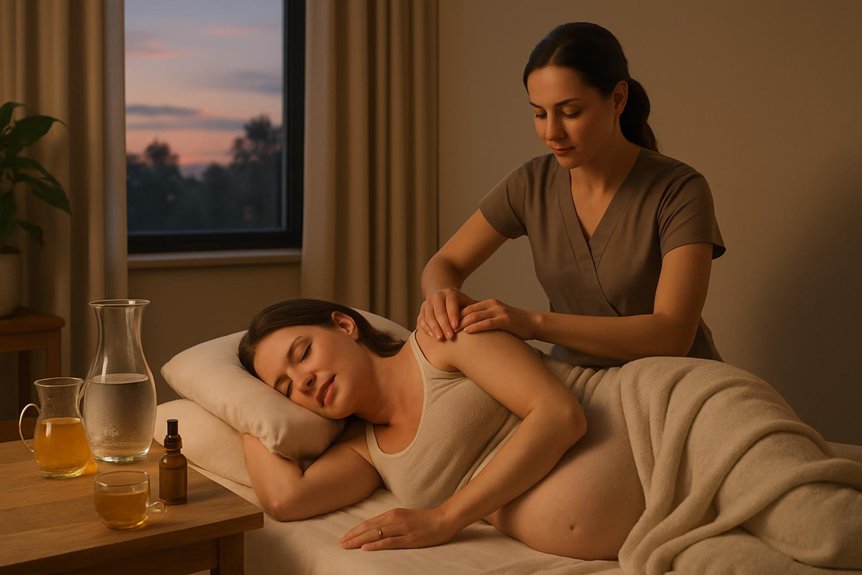
Although relaxation often continues after an aromatherapy pregnancy massage, targeted aftercare can further support comfort, sleep quality, and hydration.
At Spa & Massage, therapists advise rising slowly, sipping water within 10–15 minutes, and continuing small, frequent fluids through the day.
A light, protein‑rich snack may stabilise post‑treatment lethargy.
Gentle side‑lying rest with a pillow between knees and one supporting the bump can ease sacroiliac strain and improve sleep onset.
Warm—not hot—showers and loose clothing help preserve skin barrier function after carrier oils.
In our clinics, unscented moisturiser is recommended if skin feels tight.
Evening routines benefit from dim light, nasal breathing, and brief calf and hip stretches.
Clients are encouraged to void regularly, monitor for dizziness, and seek clinical advice if headaches, swelling, or reduced fetal movements occur.
Booking Considerations: Timing, Session Length, and Preferences
How soon to book, and for how long, depends on gestation, health status, and comfort goals. At 30 weeks, Spa & Massage recommends scheduling 7–10 days ahead, allowing time to review midwife or GP advice and any obstetric flags (e.g., hypertension, placenta previa, reduced movements).
A 60‑minute aromatherapy pregnancy massage generally balances efficacy and tolerance; 75–90 minutes may suit those accustomed to longer sessions without edema, reflux, or back pain exacerbation.
Side‑lying positioning with pillows is standard; semi‑reclined can be arranged for breathlessness.
Clients may indicate scent preferences or sensitivities; in our clinics, therapists use gentle, pregnancy‑appropriate dilutions and can provide unscented carrier oils.
Evening appointments support post‑session rest; morning slots may reduce swelling progression.
Preference notes are stored to guarantee continuity.
How Our Therapists Personalise Treatment for You and Baby
From the initial intake onward, Spa & Massage therapists individualise pregnancy aromatic massage using clinically informed screening, obstetric red‑flag checks, and client‑led goals.
Positioning is adapted for comfort and circulation—typically side‑lying with pillow support, avoiding vena cava compression.
Pressure remains moderate and region‑specific; deep work is avoided over the abdomen, medial calves, and known contraindicated points.
Oil selection is conservative. In our clinics, unscented grapeseed or light blends are primary; if aromatics are desired, only pregnancy‑appropriate dilutions are used, with patch testing and client consent.
Common choices include gentle citrus or lavender alternatives when tolerated.
Therapists modulate session flow to match fatigue, breath, and foetal movements, pausing if symptoms change.
Aftercare includes hydration guidance, gradual rises from the couch, and referral if any concerning signs appear.
Conclusion
At 30 weeks, aromatic massage can be both calming and clinically prudent—when screening aligns with midwife advice, when positioning protects circulation, and when low-dose, pregnancy-safe oils complement gentle techniques. Evidence supports reduced tension and improved sleep, provided contraindications are checked, red flags are escalated, and pressures are adapted. With timing considered and aftercare planned, comfort follows safety, and relaxation follows reassurance—coinciding needs met by measured care—so mother rests easier, baby settles quieter, and outcomes remain thoughtfully guided.
